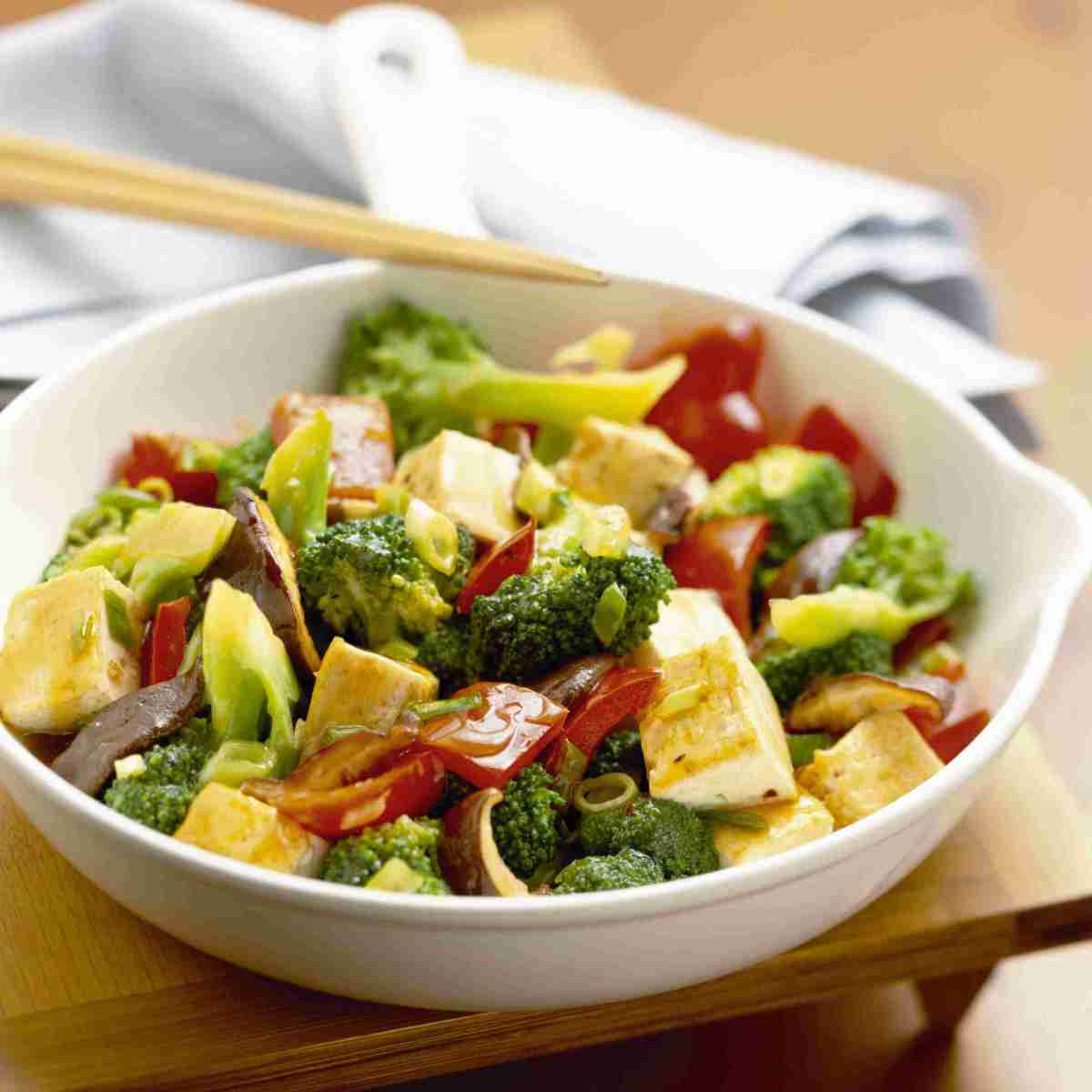Craving a vibrant, flavorful, and healthy dinner that’s ready in minutes? Look no further! This guide dives into the delightful world of quick and easy vegetarian stir-fries, offering a collection of recipes designed for even the busiest weeknights. Imagine the satisfying sizzle of vegetables hitting the wok, the aromatic steam rising, and the explosion of flavors in every bite. We’ll explore a variety of exciting recipes, essential ingredients, and creative serving suggestions, transforming your dinner routine into a culinary adventure.
From mastering the art of perfectly tender-crisp broccoli to creating mouthwatering sauces that dance on your palate, we’ll equip you with the knowledge and confidence to whip up restaurant-quality vegetarian stir-fries in a fraction of the time. Discover the secrets to unlocking vibrant colors, exciting textures, and a symphony of tastes that will leave you wanting more. Get ready to elevate your weeknight dinners to a whole new level of deliciousness and ease!
Quick & Easy Vegetarian Stir-Fry Recipes

Stir-fries are a fantastic weeknight dinner solution, offering a vibrant blend of flavors and textures in minimal time. These recipes prioritize speed and simplicity, using readily available ingredients to create delicious and healthy meals.
Quick & Easy Vegetarian Stir-Fry Recipes
Below are five vegetarian stir-fry recipes, each designed for quick preparation and maximum flavor. Cooking times are estimates and may vary slightly depending on your stovetop and preferred vegetable doneness.
- Broccoli and Peanut Stir-Fry (15 minutes): Imagine vibrant green broccoli florets tossed with crunchy peanuts in a savory peanut sauce. A simple sauce of peanut butter, soy sauce, rice vinegar, and a touch of honey or maple syrup coats the broccoli perfectly. Garnish with sesame seeds for added texture and flavor.
- Tofu and Vegetable Stir-Fry (20 minutes): Pressing the tofu beforehand removes excess water, resulting in a firmer texture that holds up well during stir-frying. Combine cubed tofu with colorful bell peppers, snap peas, and carrots. A ginger-soy sauce adds a zesty punch. Serve over brown rice for a complete meal.
- Mushroom and Spinach Stir-Fry (10 minutes): Earthy mushrooms and tender spinach create a quick and satisfying stir-fry. Sauté sliced mushrooms until browned, then add spinach and a simple garlic-soy sauce. A sprinkle of red pepper flakes adds a subtle kick.
- Eggplant and Zucchini Stir-Fry (18 minutes): Cubed eggplant and zucchini absorb the flavors of a rich tomato-based sauce beautifully. The sauce, a blend of diced tomatoes, garlic, onion, and basil, adds a vibrant Mediterranean touch. Serve with crusty bread for dipping.
- Sweet Potato and Chickpea Stir-Fry (25 minutes): Sweet potatoes, roasted until slightly caramelized, add a natural sweetness to this hearty stir-fry. Combine them with chickpeas, kale, and a warming curry-coconut milk sauce. A squeeze of lime juice brightens the flavors.
Variations of a Single Vegetarian Stir-Fry Recipe
This section explores three flavor variations of a basic vegetable stir-fry using broccoli, carrots, and snap peas.
- Sweet and Sour: A vibrant, tangy stir-fry featuring a sauce made from pineapple juice, rice vinegar, soy sauce, and brown sugar. The sweetness of the pineapple complements the crunch of the vegetables, while the vinegar provides a refreshing acidity. A sprinkle of toasted sesame seeds adds a nice nutty aroma.
- Spicy: This version incorporates a fiery kick with the addition of red chili flakes, sriracha, or a chopped fresh chili pepper to the sauce. The heat is balanced by the sweetness of a touch of honey or maple syrup and the savory depth of soy sauce and ginger. A garnish of chopped green onions adds a fresh counterpoint to the spice.
- Savory: This savory stir-fry emphasizes umami flavors. A rich sauce of soy sauce, oyster sauce (vegetarian alternative available), and garlic creates a deep, savory profile. Toasted cashews or peanuts add a delightful crunch, and a sprinkle of sesame oil enhances the overall aroma.
Nutritional Comparison of Vegetarian Stir-Fries
The nutritional content of vegetarian stir-fries can vary significantly based on the ingredients used. The following table provides an approximate comparison for three different stir-fries, per serving (approximately 1 cup). These values are estimates and may vary based on specific ingredients and portion sizes.
| Stir-Fry Type | Calories (approx.) | Protein (approx. grams) | Fiber (approx. grams) |
|---|---|---|---|
| Broccoli and Peanut | 250 | 8 | 6 |
| Tofu and Vegetable | 300 | 12 | 7 |
| Mushroom and Spinach | 180 | 5 | 5 |
Essential Ingredients & Substitutions
Creating delicious and vibrant vegetarian stir-fries hinges on selecting the right ingredients. Understanding their roles and potential alternatives allows for flexibility and creativity in the kitchen, ensuring a satisfying meal even with unexpected pantry shortages. This section explores key ingredients, substitution options, and the impact of fresh versus frozen produce on the final dish.
The foundation of any successful stir-fry lies in a harmonious blend of flavors and textures. Careful ingredient selection directly impacts the final product’s taste and visual appeal.
Common Stir-Fry Ingredients and Substitutions
A variety of ingredients contribute to the overall success of a vegetarian stir-fry. Ten common ingredients, along with suitable alternatives, are listed below. Note that substitutions may slightly alter the final flavor profile, but they often provide a viable alternative when a specific ingredient isn’t available.
- Tofu: Provides a protein-rich base. Substitutes: Tempeh, seitan, chickpeas, lentils.
- Broccoli: Adds a vibrant green color and a slightly bitter, nutty flavor. Substitutes: Cauliflower, green beans, bok choy.
- Carrots: Offer sweetness and a satisfying crunch. Substitutes: Bell peppers, zucchini, sweet potatoes.
- Mushrooms: Contribute an earthy, umami flavor. Substitutes: Shiitake mushrooms, oyster mushrooms, cremini mushrooms.
- Onions: Provide a pungent base flavor and a pleasant bite. Substitutes: Shallots, scallions, leeks.
- Garlic: Adds a strong, pungent aroma and flavor. Substitutes: Ginger, garlic powder (use sparingly).
- Soy Sauce: Offers saltiness and umami depth. Substitutes: Tamari (gluten-free), coconut aminos.
- Ginger: Adds a warm, spicy, and slightly sweet flavor. Substitutes: Turmeric, a pinch of cayenne pepper (for a spicier kick).
- Bell Peppers: Contribute sweetness and vibrant color. Substitutes: Cherry tomatoes, snow peas.
- Snow Peas: Add a delicate sweetness and vibrant green color. Substitutes: Sugar snap peas, edamame.
Fresh Versus Frozen Vegetables in Stir-Fries
The choice between fresh and frozen vegetables significantly impacts the final texture and taste of your stir-fry. Fresh vegetables, when properly handled, offer a brighter, more intense flavor and a crisper texture. However, they require more preparation time and may be less readily available or more expensive depending on the season. Frozen vegetables, on the other hand, offer convenience and year-round availability. While they might not possess the same vibrancy as fresh vegetables, advancements in freezing technology have minimized the loss of nutrients and flavor. Proper blanching and quick cooking techniques can help maintain a pleasant texture. For example, a stir-fry made with fresh broccoli florets will have a noticeably brighter green color and a more tender-crisp texture compared to a stir-fry made with frozen broccoli, which might be slightly softer.
Pantry Staples for Flavor Enhancement
A few pantry staples can elevate even the simplest vegetarian stir-fry. These ingredients add depth, complexity, and a professional touch to your dish.
- Rice Vinegar: Adds a tangy brightness.
- Sesame Oil: Imparts a nutty aroma and flavor.
- Chili Garlic Sauce: Introduces a spicy kick and savory depth.
- Hoisin Sauce: Provides a sweet and savory umami flavor.
- Dried Chili Flakes: Add a customizable level of heat.
Serving Suggestions and Variations
Transforming your quick and easy vegetarian stir-fry from a simple weeknight meal into a culinary adventure is surprisingly simple. A few thoughtful additions and creative serving methods can elevate your stir-fry to a whole new level of deliciousness and visual appeal. This section explores diverse serving suggestions and provides ideas for incorporating leftovers, ensuring no delicious bite goes to waste.
Serving your stir-fry in different ways dramatically alters its texture and overall dining experience. Consider the base you choose, the accompanying sides, and even the presentation for a truly satisfying meal.
Creative Serving Suggestions
The versatility of vegetarian stir-fries allows for endless culinary exploration. Here are five creative serving suggestions that showcase the dish’s adaptability:
- Over Fluffy Basmati Rice: Imagine the vibrant colors of the stir-fry nestled atop a bed of fragrant, fluffy basmati rice. The rice provides a comforting base, absorbing the delicious stir-fry sauce and creating a harmonious blend of textures and flavors.
- With Shirataki Noodles: For a lower-carb option, serve your stir-fry over shirataki noodles. These clear noodles have a subtle flavor, allowing the vibrant flavors of your stir-fry to shine through, while offering a satisfyingly chewy texture.
- On a Bed of Quinoa: Quinoa adds a nutty flavor and protein boost to your stir-fry. Its slightly grainy texture contrasts beautifully with the tender vegetables and creates a visually appealing and nutritionally balanced meal.
- Alongside a Crisp Side Salad: A fresh, vibrant side salad provides a refreshing counterpoint to the warm stir-fry. Consider a simple mix of greens, cucumber, and a light vinaigrette for a balanced and visually appealing presentation. The contrasting textures and flavors enhance the overall dining experience.
- Stuffed in Whole Wheat Pitas: For a fun and portable meal, stuff your stir-fry into warm whole wheat pitas. The soft pita bread complements the stir-fry’s flavors, creating a satisfying handheld meal perfect for lunch or a casual dinner.
Incorporating Leftover Stir-Fry
Clever repurposing of leftover stir-fry prevents food waste and adds exciting variety to your meals. The following examples demonstrate how to seamlessly integrate leftovers into new dishes:
- Vegetarian Omelets: Add a spoonful of leftover stir-fry to your favorite omelet recipe. The vegetables and sauce add a burst of flavor and color, transforming a simple breakfast into a more substantial and exciting meal.
- Savory Wraps: Spread a thin layer of hummus or cream cheese on a whole-wheat tortilla, add a generous portion of leftover stir-fry, and roll it up for a quick and easy lunch or snack. The combination of textures and flavors makes for a satisfying and portable meal.
- Pizza Topping: Use leftover stir-fry as a unique and flavorful pizza topping. The vegetables add a colorful and healthy twist to your pizza, complementing the cheese and sauce.
Enhancing Visual Appeal
The visual presentation of a dish significantly impacts the dining experience. A few simple techniques can transform your stir-fry from ordinary to extraordinary.
- Garnishing with Fresh Herbs: A sprinkle of fresh cilantro, basil, or chives adds a pop of color and a fragrant aroma, enhancing both the visual and olfactory appeal of your stir-fry. Imagine the vibrant green of cilantro contrasting with the colorful vegetables, creating a visually stunning dish.
- Using Colorful Vegetables: Incorporating a variety of colorful vegetables—such as red bell peppers, yellow squash, and purple carrots—creates a visually stunning stir-fry that is both appetizing and nutritious. The contrasting colors add depth and complexity to the dish, making it more inviting.
- Attractive Plate Arrangement: Instead of simply piling the stir-fry onto the plate, consider arranging it artfully. You can create a visually appealing mound, or arrange the vegetables in a circular pattern for a more elegant presentation. A simple yet effective technique is to use a contrasting color plate to further highlight the stir-fry’s vibrant colors.
With a pantry stocked with essential ingredients and a newfound understanding of flavor combinations, you’re now ready to embark on a culinary journey filled with quick, easy, and incredibly delicious vegetarian stir-fries. Remember, the beauty of stir-fries lies in their adaptability; feel free to experiment with different vegetables, sauces, and serving suggestions to create your own signature dishes. So, gather your ingredients, fire up your wok (or skillet!), and prepare to be amazed by the simplicity and deliciousness of these vibrant and satisfying meals. Bon appétit!
Quick FAQs
Can I use pre-cut vegetables for a quicker stir-fry?
Absolutely! Pre-cut vegetables can save significant prep time. Just be mindful that they may not retain the same crispness as freshly cut vegetables.
How do I prevent my stir-fry from becoming soggy?
Ensure your wok or pan is very hot before adding vegetables. Stir-fry quickly over high heat to retain crispness. Don’t overcrowd the pan.
What can I do with leftover stir-fry?
Leftover stir-fry is fantastic in omelets, quesadillas, wraps, or as a topping for salads or baked potatoes.
Are there any vegan stir-fry sauce options?
Many stir-fry sauces are naturally vegan, such as peanut sauce, sweet chili sauce, or a simple soy sauce-based sauce. Always check ingredient labels to ensure they don’t contain honey or other non-vegan ingredients.


